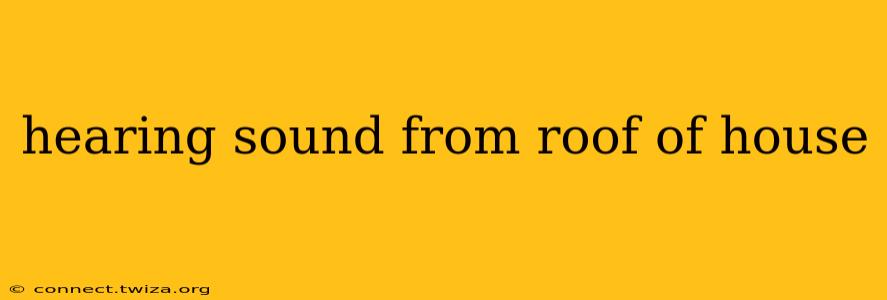Hearing unusual noises coming from your roof can be unsettling. It's a common concern, triggering worry about potential damage, pest infestations, or even more serious structural issues. This comprehensive guide will help you identify the source of those mysterious roof sounds and determine the best course of action.
What Could Be Causing the Noise?
The sounds emanating from your roof can vary widely, providing clues to their origin. Let's explore some common causes:
1. Animals:
This is often the culprit behind unusual roof noises. Different animals produce distinct sounds:
- Squirrels: Scampering, scratching, and rustling sounds, often heard during the day.
- Raccoons: Similar to squirrels, but potentially louder and more disruptive, often at night.
- Birds: Chirping, flapping, and pecking noises, usually during daylight hours. Nesting birds can be particularly noisy.
- Rodents (mice, rats): Scuttling, squeaking, and gnawing sounds, often heard at night or in quiet moments.
What to do: Identify the type of animal and consider humane removal methods. Professional pest control services are often the most effective solution, preventing further damage and ensuring the animals are relocated safely.
2. Wind:
Wind can create a variety of sounds depending on the roof's material, design, and the strength of the wind itself.
- Whistling: This often indicates gaps or loose fittings in the roof structure or around chimneys.
- Rattling: Loose shingles, flashing, or vents can rattle in strong winds.
- Creaking: The roof structure itself may creak and groan under wind pressure.
What to do: Inspect your roof for loose or damaged components during calm weather. Repair or replace any damaged areas to prevent further noise and potential water damage.
3. Rain and Hail:
These weather events can produce distinct sounds on the roof.
- Pounding: Heavy rain or hail hitting the roof can create a loud, rhythmic sound.
- Drumming: Water accumulating in gutters or on flat roofs can create a drumming effect.
What to do: Ensure your gutters are clean and free-flowing to prevent water accumulation. If you notice significant damage after a storm, call a roofing professional for an inspection.
4. Expanding and Contracting Materials:
Temperature changes throughout the day can cause the roof's materials to expand and contract, producing subtle sounds. This is particularly noticeable in older homes.
What to do: This is often a normal occurrence, especially in older houses. However, excessive creaking or popping sounds could indicate structural issues and warrant professional inspection.
5. Tree Branches:
Branches scraping against the roof can cause scratching or tapping sounds, especially during windy conditions.
What to do: Trim overhanging branches to eliminate the contact point.
Is it a serious problem? When should I call a professional?
While some roof noises are relatively benign, others require immediate attention. Call a professional roofer if you notice:
- Significant leaks or water damage: This indicates a serious problem that requires prompt repair.
- Sustained, loud cracking or popping sounds: These could indicate structural damage.
- Widespread rattling or shaking during moderate winds: This suggests loose components that need attention.
- Persistent animal noises, despite attempts at DIY pest control: Professional removal is often necessary.
Regular roof inspections, ideally twice a year, are crucial for preventative maintenance and early detection of problems. This proactive approach can save you money and prevent potentially costly repairs down the line. Remember to always prioritize safety; if you are uncomfortable inspecting your roof yourself, call a qualified professional.
